




SEPTEMBER 2023 • Vol.10 • No.09 (ISSN 2564-1999)
IF HR OWNS EMPLOYEE EXPERIENCE, YOU’RE DOING IT WRONG
The State of Human Experience in the Workplace 2023 Page 17 - 42 Sponsored by
- Cyndi Wenninghoff, Director, Employee Success, Quantum Workplace Design



If HR Owns Employee Experience, You’re Doing It Wrong Employee experience deserves the same obsessive focus we give to customer experience - Cyndi Wenninghoff, Director, Employee Success, Quantum Workplace Design 07 INDEX On the Cover Human Experience Excellence - Engagement, Performance, Rewards & Recognition SEPTEMBER 2023 Vol.10 No.09 Articles The State of Human Experience in the Workplace 2023 Page 17 - 42 (ISSN 2564-1999) 15 Phantom Culture Exposed: Unraveling The Unspoken Realities A deep dive into the factors defining your company’s true culture - Candice Gottlieb-Clark, Founder & CEO, Dynamic Team Solutions 46 Employee Engagement In The Digital Era: Communication Strategies To Engage All Generations Of Workers Unlocking employee loyalty through inclusive language and mentorship programs - Dr. Laurie Moroco, Business Coach & Keynote Speaker, Lauriemoroco.com 56 How To Help Employees Offset Inflation— And Earn Lasting Loyalty In The Process Enhancing employee engagement through smart incentives - Marina Hodges, Senior Director and Head, Incentives Marketing, Blackhawk Network
7 Ways To Recognize And Reward High Productivity In Employees
Elevating employee performance through well-thought-out strategies
- Brett Farmiloe, Founder, CEO and CHRO, Featured
Top Picks 10 43
The Truth Behind The “Lazy Girl” Phenomenon
Employers must own their contribution to the #lazygirljob trend
- Ian White, CEO, CTO, and Founder, ChartHop
INDEX
Engaging Employees & Building Connections Amid Changing Trends And Economic Uncertainty



Five trends HR pros need to know about –they all point to a need to foster connection
 - Brenda Pohlman, Practice Leader, Workhuman
- Brenda Pohlman, Practice Leader, Workhuman
50 59
10 Steps For Managers To Transform Workplace Mistakes Into
Opportunities
From missteps to milestones
- Shiela Mie Legaspi, President, Cyberbacker Inc.
Human Experience Excellence - Monthly Interactive Learning Journal

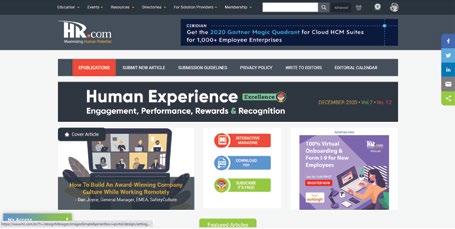
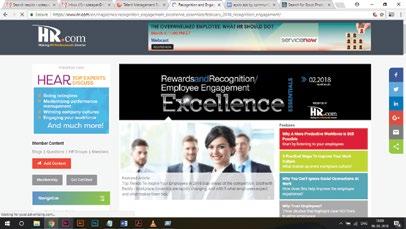
The future is all about going beyond the employee experience to focus on human experience. This monthly interactive learning experience showcases strategies and programs to improve employee performance and strengthen your team.
Human Experience Virtual Events
Virtual Events in the Recognition and Engagement track will give you everything you need to recognize and reward employees creating an inspired workforce and organization that will drive innovation and boost productivity. Sessions feature the world’s top thought leaders in the recognition and engagement space covering topics from customer loyalty, safety, sales, company culture and motivation to what makes an effective and efficient results-based program. Each Virtual Event consists of up to 10 credit webcasts.
Human Experience Webcasts for Credit
HR.com webcasts deliver the latest Recognition and Engagement industry news, research trends, best practices and case studies directly to your desktop. Webcasts are available live online with a downloadable podcast and a copy of the slides (PDF) available before and after each webcast. Earn all of the required recertification credits for aPHR, PHR, SPHR, GPHR, and SHRM Certifications. HR.com’s one-hour webcasts, in every HR specialty including HRIS and Payroll, are pre-approved for HRCI and SHRM credit (excluding Demo webcasts).
IHR Rewards and Recognition Community
Join almost 25,600 HR.com members with a similar interest and focus on rewards and recognition. Share content and download research reports, blogs, and articles, network, and “follow” peers and have them “follow” you in a social network platform to communicate regularly and stay on top of the latest updates. This well established Rewards and Recognition Community is an invaluable resource for any HR professional or manager.
SEP 2017 Vol. 5 No. 09 JANUARY 2021 Vol.08 No.01 18 12 25 30 Digital Is All The Rage: Why Employee Rewards Must Include Digital Options In 2021 - Theresa McEndree, Blackhawk Network Employee Experience Trends In 2021Tips To Increasing Your Reward And Recognition Strategies Post-Covid - Richelle Taylor, One10 How To Create Meaningful - Mike Byam, Terryberry HOW TO EMBRACE THE SHIFTS THAT OCCUR AS WE RETURN TO A NEW NORMAL WORKPLACE Key workplace trends for 2021 - David Roberts, Chief E�ecutive �fficer, �lchemer �hemed Edition on Agile Reward & Recognition Strategies How are our Human Experience Products and Services helping to make you smarter? Use these invaluable Human Experience resources today! For more information phone: 1.877.472.6648 | email: sales@hr.com | www.hr.com
Editorial Purpose
Our mission is to promote personal and professional development based on constructive values, sound ethics, and timeless principles.
Excellence Publications
Debbie McGrath CEO, HR.com - Publisher
Sue Kelley Director (Product, Marketing, and Research)
Babitha Balakrishnan and Deepa Damodaran
Excellence Publications Managers and Editors
Human Experience Excellence Team
Babitha Balakrishnan and Koushik Bharadhwaj Editors
Arun Kumar R Design and Layout (Digital Magazine)
Vibha Kini Magazine (Online Version)
Submissions & Correspondence
Please send any correspondence, articles, letters to the editor, and requests to reprint, republish, or excerpt articles to ePubEditors@hr.com
For customer service, or information on products and services, call 1-877-472-6648
Debbie Mcgrath Publisher, HR.com
Babitha Balakrishnan Editor, Human Experience Excellence

Elevating Employee Experiences: Strategies for a Flourishing Workplace
Inrecent years, there has been a noticeable shift in employers' dedication to enhancing the employee experience. Yet, a significant question remains: have these efforts genuinely improved the day-to-day experiences of employees? The entire landscape of business operations, from recruitment and onboarding to talent retention, is evolving to meet the expectations of a more informed workforce. At the heart of this transformation lies the quest to humanize the overall employee experience.
Across the globe, organizations are grappling with the challenge of retaining their top talent while simultaneously cultivating a positive workplace atmosphere. Recognizing outstanding contributions from employees has never been more crucial as employee engagement and productivity take center stage in today's business environment.
In this edition, we've gathered insights from industry experts to tackle these important issues and offer actionable strategies for fostering a positive workplace culture.
Also included is an exclusive research study by the HR Research Institute entitled, The State of Human Experience in the Workplace 2023. The exclusive research report presents crucial findings on the challenges faced by organizations in achieving high ratings for employee experience, managing it through technology, and dealing with burnout.
Cyndi Wenninghoff (Director of Employee Success at Quantum Workplace), sheds light on the pivotal role of HR, leadership, and technology in shaping an engaging employee experience in her article, If HR Owns Employee Experience, You're Doing It Wrong. The article draws parallels between the employee and customer experience, underscoring the importance of organizations prioritizing employee-centric strategies.

In his article, 7 Ways To Recognize And Reward High Productivity In Employees, Brett Farmiloe (CEO & Co-Founder of Featured) compiles valuable insights from industry experts. From comprehensive rewards and career development to unique "Kick-Ass" awards, this article offers a comprehensive guide for organizations seeking to boost morale and motivate their workforce.
Ian White (CEO, CTO & Founder at ChartHop), delves into the "Lazy Girl" job trend in his thought-provoking piece, The Truth Behind The 'Lazy Girl' Phenomenon.
Brenda Pohlman (Practice Leader at Workhuman) explores strategies to foster workplace connections amid changing trends and economic uncertainty in her article, Engaging Employees & Building Connections Amid Changing Trends And Economic Uncertainty. As we navigate this evolving terrain, it's clear that the employee experience is not just a buzzword but a fundamental aspect of contemporary business success. By embracing employee-centric strategies and fostering an environment of support, learning, and recognition, organizations can position themselves for growth and prosperity in the ever-changing world of work.
We hope you find the articles in this edition informative and inspiring as you embark on your journey to enhance the employee experience within your organization. As always, we eagerly await your valuable feedback and suggestions.
Happy Reading!
Disclaimer: The views, information, or opinions expressed in the Excellence ePublications are solely those of the authors and do not necessarily represent those of HR.com and its employees. Under no circumstances shall HR.com or its partners or affiliates be responsible or liable for any indirect or incidental damages arising out of these opinions and content.
EDITOR’S NOTE
For Advertising Opportunities, email: sales@hr.com
© 2023 HR.com. No part of this publication may be reproduced or transmitted in any form without written permission from the publisher. Quotations must be credited.
Copyright
Human Experience Excellence (ISSN 2564-1999) is published monthly by HR.com Limited, 56 Malone Road, Jacksons Point, Ontario L0E 1L0
Address: www.hr.com Write to the Editor at ePubEditors@hr.com
Internet
In a world of unparalleled challenges (global pandemic, racial injustice, political rivalry, digital 4.0, emotional malaise), uncertainty reigns. Finding opportunity in this context requires harnessing uncertainty and harnessing starts with reliable, valid, timely, and useful information. The Excellence publications are a superb source of such information. The authors provide insights with impact that will guide thought and action.

Excellence publications are my ‘go-to’ resource for contemporary and actionable information to improve leadership, engagement, results, and retention. Each edition offers rich and diverse perspectives for improving the employee experience and the workplace in general.





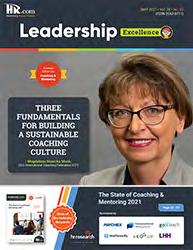
I regularly read and contribute to Leadership Excellence and Talent Management Excellence. I use many of the articles I read to augment my own presentations and I often share the articles with my clients. They are always quick, right on target for the latest issues in my field, and appreciated by my clients. If you want to stay up to date on the latest HR trends, choose a few of the different issues from the Excellence series of publications.







We’re eager to hear your feedback on our magazines. Let us know your thoughts at ePubEditors@hr.com
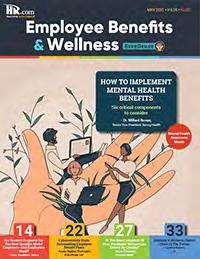
 Dave Ulrich
Rensis Likert Professor, Ross School of Business, University of Michigan Partner, The RBL Group
Dave Ulrich
Rensis Likert Professor, Ross School of Business, University of Michigan Partner, The RBL Group
WHY EXCELLENCE PUBLICATIONS?
Julie Winkle Giulioni Author, Virtual /Live Keynote Presenter, Inc.’s Top 100 Leadership Speakers
Dr. Beverly Kaye CEO, BevKaye&Co.
If HR Owns Employee Experience, You’re Doing It Wrong
Employee experience deserves the same obsessive focus we give to customer experience
By Cyndi Wenninghoff, Quantum Workplace Design
The centrality of the customer experience is a given in business, and there’s no shortage of companies claiming to be “obsessed” with that experience.
Consider for a moment, though, what it would be like if we devoted that same intense focus to the experience of employees.
We’d listen intently to employee opinions all the time rather than just during annual survey seasons. When that feedback surfaces problems, we’d co-create solutions with employees. We’d hardwire processes to fine-tune our efforts and report on their success.
We’d set KPIs (key performance indicators) for employee engagement, work to meet them, and regularly review them. And we’d do it at every level of the organization–from the C-suite to the front line. We’d treat talent like what is: the biggest expense and biggest opportunity in the organization.
In short, we’d make the employee experience everyone’s responsibility.
I’d argue that in the working world we all inhabit now, obsessive focus on employee experience is
imperative. Of all the things transformed by the Covid-19 pandemic, nothing shifted as much as the experience of work. For millions of people, remote work and schedule flexibility have become the norm.
As work has moved from the office to the home, companies may feel they have less control than ever on the employee experience. But the in-office experience isn’t as decisive in shaping the overall employee experience as we may have thought–only 28% of workers experience company culture most strongly through the physical workplace
Human Experience Excellence presented by HR.com September 2023 7 Submit Your Articles
COVER ARTICLE
Even in a remote work world, there is a tremendous opportunity to create a more engaging employee experience. But the key to seizing it is making a company-wide commitment.
So what does that look like?
Empowered HR
Human resources (HR) may not have the role you expect in many organizations - HR is the nominal owner of employee experience. But in a culture that obsesses over that experience, HR becomes the essential enabler, driving alignment across the organization, coaching leaders and teams, and equipping everyone with the tools and processes.
By choosing processes and tools that help you measure and drive engagement, HR equips and aligns leaders, managers, and employees to build an experience-first culture. Tool choices are particularly important. With homegrown or bare-minimum solutions, you’re likely to hit obstacles with adoption and usage. Ideally, you want to invest in technology that your leaders, managers, and employees actually enjoy using—and that integrates with the tools they’re already using to get their work done day to day.
Empathic Leadership
Leaders are the most influential people in your organization. An extraordinary employee experience is impossible without leaders who prioritize
engagement, clearly communicate their engagement strategy, and listen intently to employees.
That last point is an important one. In a 2021 study by the global nonprofit Catalyst, 76% of people said working for empathetic senior leaders made them more engaged with their work. Sixty-one percent said they work more creatively because they believe their senior leaders show empathy. The connection between empathetic leadership and improved results is real, and it’s clear.
Enabled Management
Managers are essential. As the people closest to the actual employee experience, they’re uniquely positioned to see and address problems with it. Experience-first organizations give managers the clarity to champion and track team progress on organizational priorities. They also equip managers to create safe spaces where workers can get and give meaningful feedback. Employees who get feedback at least monthly are 1.4 times more likely to stay with an organization
Technology plays a significant role in enabling managers. Easy-to-use engagement tools facilitate ongoing conversations, and good performance tools can focus on those exchanges. The right solutions help create an environment where managers can act on employee feedback quickly and simplify their listening processes.
Engaged Employees
That leaves the employees themselves, and their role is to be heard and help develop solutions to make work better. In an experience-focused culture, soliciting and acting on employee opinion is a continuous priority. It can’t only happen through annual employee engagement surveys that may or may not shape company priorities and initiatives.
An extraordinary employee experience demands a holistic approach to employee listening. It has to happen at several levels: individually, through 1:1 meetings, team huddles, and lifecycle interviews; communally, via town halls and focus groups; and across the organization, through regular pulse surveys and yearly satisfaction surveys.
Human Experience Excellence presented by HR.com September 2023 8 Submit Your Articles
If HR Owns Employee Experience, You’re Doing It Wrong
The feedback collected across those layers of listening is valuable data, and it needs to be treated as such. Capture it, track it, act on it, and report on progress, just as you would data on core products or customer perceptions. And make sure employees are part of every step in that process – you’ll get better solutions if employees help you develop and execute them.
The employee experience can be a competitive advantage, but only if the entire organization commits to it. Put your employee experience on par with your customer experience, and you empower leaders, HR professionals, managers, and workers to transform the workplace in ways that engage and benefit everyone.

Cyndi Wenninghoff is the Director of Employee Success at Quantum Workplace. She is also a People Leader with over 10 years of people operations and human resources experience, with a focus on talent acquisition and employee engagement.
Would you like to comment?

Human Experience Excellence presented by HR.com September 2023 9 Submit Your Articles
If HR Owns Employee Experience, You’re Doing It Wrong
7 Ways To Recognize And Reward High Productivity In Employees

Elevating employee performance through well-thought-out strategies
By Brett Farmiloe, Featured
To shed light on how to effectively recognize and reward high-performing employees, we’ve gathered seven insightful methods from human resources (HR) leaders and CEOs. From implementing
a comprehensive reward and recognition system to introducing a unique “Kick-Ass” award for visibility and recognition, these strategies have proven successful in acknowledging and motivating top performers.
1. Implement Comprehensive Rewards and Recognition
2. Provide Tiered Bonuses, Public Recognition, and Development Opportunities
3. Include Performance-Based Promotions, Raises, and Bonuses
4. Empower Top Performers with Project Autonomy
5. Personalize the Reward Portfolio for Top Performers
6. Motivate with Career Development and Continuous Learning
7. Introduce the “Kick-Ass” Award
Human Experience Excellence presented by HR.com September 2023 10 Submit Your Articles
TOP PICK
Implement Comprehensive Rewards and Recognition
At Custom Neon, we reward our team in a number of different ways. We prioritize celebrating our team’s performance through employee-of-the-quarter awards, top sales, and design of the month, with recognitions being announced in global monthly meetings. Team anniversaries are also honored.

These are small but impactful things that we do to share appreciation with our team. Our rewards include salary increases for strong performance and individualized bonuses for going above and beyond. Instead of only monetary incentives, we offer gift cards, trips, sports tickets, and gym memberships to align with personal interests.
Additionally, we introduced a career development framework, allowing recognition for tenure and experience. Team members can achieve “senior” status after a year to acknowledge outstanding performance and skills. One of our core values is that we are powered by passion, and we instill this in our team. We are proud to see personal growth and will always reward accordingly.

Provide Tiered Bonuses, Public Recognition, and Development Opportunities
One example of a successful incentive program is a tiered bonus system. This approach rewards employees who meet or exceed their performance targets with a bonus that increases as they surpass higher milestones. For instance, an employee who meets their target may receive a 5% bonus, while those who exceed their goal by 10% receive a 10% bonus, and so forth.
Another way to acknowledge and motivate top performers is through public recognition, such as Employee of the Month awards, Certificates of Achievement, or even praise during team meetings. With this method, employees feel appreciated and valued for their contributions to the company.
Furthermore, offering additional training or development opportunities for highperforming employees can incentivize them to continue working hard. This investment in their career advancement can motivate them to maintain their high level of productivity and continue contributing to the company’s success.
Human Experience Excellence presented by HR.com September 2023 11 Submit Your Articles 7 Ways To Recognize And Reward High Productivity In Employees
Jessica Munday, People and Culture Manager, Custom Neon
Rejoyce Owusu, Owner and VP of HR, UMATTA CONSULTING LLC
Gordana Sretenovic, Co-Founder, Workello ATS

Include Performance-Based Promotions, Raises, and Bonuses
People work for money and recognition, so money and recognition are what we give to employees who consistently demonstrate amazing work and get stuff done. Our top performers can always expect to be properly credited for their work, receive regular promotions that correlate with their performance, and, of course, get raises and bonuses as they demonstrate an incredible work ethic and hit KPIs (key performance indicators).
Our promotion and bonus path is public to everyone in the company, so, at any point in time, our employees can evaluate themselves against the scale and understand exactly what they need to do to advance to the next level.
Phil McParlane, Founder and CEO, 4dayweek.io

Empower Top Performers with Project Autonomy
One effective method that HR leaders can adopt is granting project autonomy. This involves entrusting top performers with the reins of their projects, providing them with creative freedom and decision-making authority. When employees are empowered to lead, they not only feel valued but also motivated to excel, as their contributions directly impact the project’s success.
By allowing top performers to take the lead, organizations tap into their expertise and innovative thinking. When employees have the freedom to make strategic choices, they’re more engaged and invested in their work. This approach acknowledges their dedication and recognizes their ability to drive results independently.
In this incentive program, high productivity is rewarded by promoting a culture of trust and responsibility. Employees who consistently demonstrate exceptional performance are given the opportunity to showcase their skills and lead their peers. This approach has done wonders.
Human Experience Excellence presented by HR.com September 2023 12 Submit Your Articles
7 Ways To Recognize And Reward High Productivity In Employees
Personalize the Reward Portfolio for Top Performers
When employees are consistently performing well, they’re accustomed to achieving rewards. Engage these top performers to learn what types of rewards resonate with them. Create a small portfolio of varied rewards aligning with their preferences to ensure the company’s human capital investment yields a respectable ROI (return on investment).

If the selection of monetary and non-monetary rewards is limited, some top performers may become desensitized to these variables over time. Explore channels of communication that permit the entity to learn how employees optimally perform well while extracting job satisfaction.
Chances are high that the top performers are ambitious personalities, to begin with, and most of them will perform well for their own sake. Rewarding them still matters because there are always other third parties who can benefit from their contribution. Discover how to keep this professional relationship alive without both parties falling prey to an eventual decline in job satisfaction.
Motivate with Career Development and Continuous Learning
Since adding knowledge and skills goes hand-in-hand with career development, we have found this continuous learning strategy to help drive our top performers, too. After all, even LinkedIn tells us that 94% of employees would stay longer if their company committed to career development. And what better way to keep and motivate top performers?

An advantage we always have in this direction is all the learning we can distribute across all levels of our firm. While promising paralegals and attorneys fresh out of law school have something new to learn daily, structuring this learning through special programs helps them understand how much they can achieve by working with us.
When we commit to their development and line-up learning programs, they understand and acknowledge our firm’s commitment to them and reciprocate with renewed commitment and drive.
Human Experience Excellence presented by HR.com September 2023 13 Submit Your Articles 7 Ways To Recognize And Reward High Productivity In Employees
Riley Beam, Managing Attorney, Douglas R. Beam, P.A.
Sasha Laghonh, Founder, Sasha Talks
Introduce the “Kick-Ass” Award
At our company, recognizing and rewarding employees who consistently exhibit high productivity is a crucial part of our culture. One successful initiative we’ve implemented is the “Kick-Ass” award.



This program not only acknowledges exceptional performance but also motivates our top performers. Recipients of the “Kick-Ass” award receive a financial bonus as a tangible recognition of their hard work.
Moreover, they’re given a unique opportunity to showcase their achievements by presenting their work at our next company meeting. This not only boosts their confidence and visibility within the organization but also fosters a sense of pride and healthy competition among the team. The “Kick-Ass” award has proven to be an effective way to acknowledge dedication and drive while reinforcing a culture of excellence.
Human Experience Excellence presented by HR.com September 2023 14 Submit Your Articles
you like to comment? Brett Farmiloe is the
7 Ways To Recognize And Reward High Productivity In Employees
Would
Founder, CEO and CHRO of Featured
Michael Loesche, M.D., Ph.D., CEO, USMLE Test Prep
Phantom Culture Exposed: Unraveling The Unspoken Realities
A deep dive into the factors defining your company’s true
culture
By Candice Gottlieb-Clark, Dynamic Team Solutions
Google the words “company culture,” and you’ll find nearly ¾ billion results. Yet, ask business leaders to define their company’s culture or to discuss ways their culture was created or changed, and the results are minimal. Company culture, it seems, is a bit of an enigma.
On the surface, it’s often characterized as a product of the company’s values, beliefs, and behaviors. But when the stated values, beliefs, and behaviors take a detour from the reality of daily business activities, the culture isn’t living up to the mission of the organization. And most certainly, the employees know it, further destabilizing the potential of that purported culture to ever take hold. As an added concern, the opportunity for the company culture to positively impact clients, customers, and consumers is lost as well.
So, where does the declared culture separate from reality? The divide occurs through daily interactions and decisions through policies and practices. Look at the following to determine where your culture is truly defined:
Rewards. Who and what is promoted in your company? Are the hardest and most competent
workers rewarded in kind? Do employee attitudes or workplace relations factor into opportunities and pay raises? How are requests for paid time off granted? Also looks at areas of nepotism, loyalty (regardless of competency), and highest sales performance (regardless of attitude). How each of these is rewarded will also impact your company culture.
Punishment. Who is terminated and why? Does poor behavior, insubordination, dishonesty, or other problem behavior get addressed – and punished – in a swift and decisive manner? Are problem people allowed to move about seemingly untouched? How many opportunities is staff given to change/improve before consequences set in?
Communication. How open are the channels of communication? Do staff have a voice in discussing things that impact them – like a new computer program or a recent update to how workload is to be calculated? Or are they blind-sided or surprised by things that are occurring or changes that are implemented? Can staff adequately rely on the chain of command for getting information to or from where it needs to be? Is communication one-way (i.e., top-down) or reciprocal?
Human Experience Excellence presented by HR.com September 2023 15 Submit Your Articles
Teamwork. How do people work together? Are teams thoughtfully created with competent leaders put in charge? Is blame or finger-pointing a problem? Are accountability and personal responsibility being reinforced? Are collaboration and operational reciprocity a reality, or are people or divisions siloed and disconnected?
Conflict Management. How are tensions or conflicts managed? Are people encouraged to seek help or left to deal with issues themselves? Are people in leadership roles trained in basic conflict management? When help is offered, is it legitimate and multi-tiered or superficial and temporary? Do managers and leaders receive training in employee relations or conflict management?
The above questions offer just the start for examining the factors that determine your company’s true culture. We hope they pose a healthy challenge to all

companies looking to create or improve their own company culture.

This article was originally published here
Would you like to comment?
Human Experience Excellence presented by HR.com September 2023 16 Submit Your Articles
Phantom Culture Exposed: Unraveling The Unspoken Realities
Candice Gottlieb-Clark is the Founder & CEO of Dynamic Team Solutions and a renowned business advisor, leadership coach, and conflict management specialist. Candice is also the author of the bestselling leadership book Find, Fix, Fill Your Leadership Gap.





Sponsored by: Build workplaces that maximize employee potential
State of Human Experience in the Workplace 2023 INTERACTIVE SEPTEMBER 2023 Special Research Supplement September 2023
The
The State of Human Experience in the Workplace 2023
Exclusive Study By The HR Research Institute
Survey conducted by: Sponsored by:




ARTICLES Fertility at work A global report from Carrot Fertility
6 Ideas to Create a Positive Employee Experience
By Sarah Mulcahy, Director of Content Marketing
33
Embracing Flexibility, Possibility, and Humanity: Shaping the Future of Work
By Jaime Faulkner, Content Manager
37
Developing a Connected Culture to Attract Talent, Retain Top Performers & Deliver Results
By Tim Schieffer, Insights and Strategy Leader


The HR Research Institute, powered by HR.com, the world’s largest social network for Human Resources professionals, is a key part of our mandate to inform and educate today’s HR professionals. Over the past three years, the HR Research Institute has produced more than 85 exclusive primary research and state of the industry reports, along with corresponding infographics in many cases, based on the surveys of thousands of HR professionals. Each research report highlights current HR trends, benchmarks, and industry best practices. HR Research Institute Reports and Infographics are available online, and always free, at www.hr.com/featuredresearch


RESEARCH REPORT SUMMARY
INDEX 19
24
28
The State of Human Experience in the Workplace 2023
Build workplaces that maximize employee potential
Sponsored by:


Current economic trends make employee experience complex to address. As we write this report, we are in uncertain times. As of December 2022, the U.S. unemployment rate continues to be a low 3.5%, and organizations continue to worry about retaining their best performers. However, many organizations in the technology sector have been undergoing massive layoffs, and business leaders worry that a recession could occur in the overall U.S. or even the global economy in 2023.
Even before this period of high employee turnover, however, many organizations had started focusing more on the experiences of employees as well as other organizational stakeholders.

Although employee engagement remains important, this broader focus on experience was viewed as a needed corrective. Where engagement is seen as the pathway to gaining more productivity from employees, experience is about helping employees bring their authentic selves to work and feel good about staying. So, where does that leave us today? That depends on the industry and specific employer.
Considering the importance of these trends, The HR Research Institute conducted an exclusive study entitled The State of Human Experience in the Workplace 2023 to understand the state of human experience in the workplace.

19
RESEARCH REPORT SUMMARY STATE OF THE INDUSTRY RESEARCH
Exclusive Study by The HR Research Institute
Key Findings
● Most organizations don’t rate themselves highly on employee experience.
● Most organizations measure the employee experience in some way, but there’s no consensus on the best way, and some primary methods are reactive rather than proactive.
● Fully 86% of organizations use technology to track, gauge and otherwise manage employee experience.
● Positive employee experience is driven by social connections and deterred by employee burnout.

● Most HR professionals have a positive feeling about the future of employees experiences and expect a rise in importance in the near future.
● The success of employee experience initiatives depends on adequate funding and commitment from immediate supervisors.
Most of Today’s Organizations Report Lackluster Employee Experience Scores
Respondents were asked to rate the overall employee experience (EX) in their organizations on a scale of 1 (terrible experience) to 10 (top-notch experience). Just 16% give it a high rating of 9 or 10, though another 28% give it a rating of 8. Over half of the organizations (56%) rate the average employee experience in their organization as just mediocre or worse (that is, 7 or below) on a 10-point scale, and nearly a third report that the average employee experience in their organizations is 6 or below.
Organizations are overwhelmingly
about the customer and supplier/ vendor experience
Eighty-three percent of organizations say customers of their organization would rate their experience as good or excellent. Roughly the same percentage say this about their suppliers/vendors.
20
positive
RESEARCH REPORT SUMMARY STATE OF THE INDUSTRY RESEARCH
Survey Question: How do you think these groups in your organization would rate their experiences?
Some Aspects of the Employee Experience Are Better Than Others
To get a better feel for the relative strength of these factors in today’s workplace, we asked HR professionals to rate the extent to which they agree with statements on employee sentiment.
Although half or more respondents agree or strongly agree with all listed statements, there was much greater agreement in some areas than in others. For example, fully 80% agree to some extent that employees in their organizations are comfortable “bringing their whole self to work.” However, even here, only 21% strongly agree with the statement, suggesting that many HR
professionals understand that there are significant exceptions and that they lack a deep understanding of the challenges facing certain groups of employees at work.
Measuring the Employee Experience Is Largely Done Through Retrospective and Arguably Dated Methodologies
We asked respondents to choose the tools, technologies, and/or methods that their organizations use to measure the experiences of their employees. Encouragingly, the majority of organizations (94%) measure employee experience in some way.
21 RESEARCH REPORT SUMMARY STATE OF THE INDUSTRY RESEARCH
Good Excellent Poor Below average Average 0 20 40 60 80 100 Suppliers/Vendors Customers 27% 58% 13% 36% 47% 13% 1% 3% 3% 1%
Survey Question: Which tools, technologies or methods does your organization use to measure the experiences of employees? (select all that apply)
Exit interviews
One-on-ones
Employee recognition programs
Annual surveys
Performance management system
Pulse surveys (including net promoter tools)
Employee communication tools (e.g., Slack)
Open feedback tools (such as online suggestion box always available to employees)
Anonymous two way conversations
Whistleblowing software for compliance
Passive analytics (i.e., data collected without involving data provider)
Focus groups
22 RESEARCH REPORT SUMMARY STATE OF THE INDUSTRY RESEARCH
0 10 20 30 40 50 60 70 80 65% 64% 57% 55% 49% 36% 35% 29% 25% 16% 15% 13%
Just over onethird use pulse surveys to measure employee experiences
Most Use Technologies to Affect Employee Experience, but There’s No Consensus on Which Ones to Leverage
When asked about the technologies they use to “track, gauge and otherwise manage or influence employee/human experience,” 86% say they use some kind of technology. Fifty-five percent of respondents use survey tools, and nearly the same percentage (54%) use performance management technologies. In addition, over two-fifths utilize employee feedback and communication tools (45%), L&D tools (44%) and onboarding systems (42%).
Social Connections, Meaningful Work and Fair Compensation Positively Influence Employee Experience, Whereas Burnout Negatively Affects It
To determine the top issues that positively influence employee experience, we asked respondents to choose the top five issues impacting employee experience. Feelings of camaraderie and friendship with coworkers (45%) top the list, followed closely by a sense of meaning and purpose (41%), work/life balance (40%),
opportunities to learn (39%), and ability to grow within the organization (39%).
Employee Burnout Most Negatively
When asked to choose the top five issues negatively impacting the experiences of employees, a majority of respondents chose employee burnout (55%), making it the most widely cited factor. Other HR Research Institute studies have also indicated that stress and burnout are among the foremost factors negatively affecting employee experience.
About three-fifths of respondents agree or strongly agree that employee experience will improve over the next year. However, 31% neither agree nor disagree, and 10% actively disagree.

To learn more about human experience in the workplace, and for key takeaways and recommendations on The State of Human Experience in the Workplace 2023, check out the full report.
Read the Research Report

23 RESEARCH REPORT SUMMARY STATE OF THE INDUSTRY RESEARCH
6 Ideas to Create a Positive Employee Experience
Sarah Mulcahy, Enboarder
Why a positive employee experience matters
With all the changes we’ve experienced in the workplace these past few years – from an increase in hybrid work, to reductions in force, and the tight labor market – the task of creating a positive employee experience can feel like a moving target.
Yes, the work of improving employee experience is never really done. But sometimes the best way to spark an idea for your people programs and initiatives is to listen and learn from your peers.
Enboarder’s Global Director of Customer Success, Chris Jones, recently sat down with a panel of HR leaders to discuss how they’re doubling down on connection and belonging to create positive employee experiences at their companies. The panel included Jenny Davis, Continuous Improvement Manager (People Team), OVO, Kelly Pope, Onboarding Coordinator, Eurest, and Sylvia Flores, Chief of Brand, Espresa.
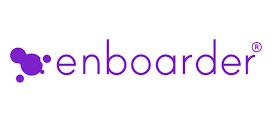
Here we share six key takeaways from their conversation.
Show appreciation through employee recognition.
When you get caught up in day-to-day tasks, it can be easy to miss the smaller moments that deserve recognition and appreciation. That’s especially true in the food service industry, shared Kelly, where the focus is often on a seamless customer experience,
and not necessarily the experience of front-line workers. Eurest is looking to change that with a new employee recognition program called Hero. “It’s an internal opportunity for guests or other team members to recognize others for a job well done,” she said.
And while there is a monetary component to the program in the form of gift cards, the most important part of Hero is letting employees know how their work is appreciated by the company. To build a positive employee experience, start with belonging.
Nearly every company will tell you they care about belonging, but who actually lives it? Jenny shared that OVO hired a belonging consultant to carry out the vision of belonging and inclusion that the company’s founder had set – where everyone is valued for who they are as an individual. One aspect of OVO Belonging is employee networks that are open for anyone to join. These are centered around common interests, such as neurodiversity, generations, pride, and accessibility.
“Rather than being a once-a-year thing we talk about just before the engagement survey, we’ve woven belonging into all our communications,” shared Jenny. That includes weekly employee emails and town hall topics, and it’s even woven into OVO’s recruitment process through Enboarder.
STATE OF THE INDUSTRY RESEARCH 24 ARTICLE
Go beyond the paperwork during onboarding.

Both Kelly and Jenny shared how streamlining their onboarding processes with Enboarder has allowed them to focus more on human connection during key moments in a new hire’s journey. “We are big Enboarder lovers over here. I couldn’t do what I do without having some many automated pieces,” said Kelly. She’s especially excited about the opportunity to bring back in-person onboarding classes this year. “The value is truly in that teambuilding and connection with the people they’re onboarding with.”
Crafting "iconic moments"
Jenny also shared her excitement about building in more “iconic moments” into the employee experience at OVO. “If somebody becomes a parent for the first time or they’re promoted or move internally, these are all different touchpoints where we have an opportunity to support our people, but also pair it with technology so it’s scalable,” she said.
The first iconic moment Jenny was tasked with improving was onboarding. In partnership with Enboarder, OVO “completely transformed the endto-end journey” and now has a 120-day guided journey that starts four weeks before new hires join the company. OVO went from 15% automation in the onboarding process to 85%, which means people managers and HR can focus more on connecting with new hires on a personal level.
on connecting with individual and understanding – outside of the admin tasks – what they need as a person to be able to transition into the company and really feel like they’re adding to value quicker into their career with us,” shared Jenny.
Give people managers the tools to succeed.
According to CEB, 60% of new managers fail in their first 24 months in the role. Oftentimes rockstar individual contributors get moved into people management without any formal training or guidance.
Kelly shared how Eurest is taking a different approach when it comes to professional development for managers – and it all starts during onboarding. “We hold a soft skills live class … It’s a really fun class to focus on some of the intangible, non-operational skills during their onboarding,” she said. Some of the topics covered include team building, DISC personality assessments, and business etiquette. “It’s amazing to see those light bulbs start going off for people, whether they’re new leaders or they’ve been a leader before. It’s cool to see them get that spark of energy to go out and improve their teams.”
When it comes to communication, meet employees where they’re at.
“One of the first people leaders to go through the journey reached out to tell me, ‘It’s a week to go before Ashley joins. I found out she’s in the same city as me, so I’m meeting her for coffee and cake on Friday’ … That was why we did that piece of work, so that our people leaders could concentrate
Jenny shared that OVO has multiple touchpoints for internal communication, including a weekly all-company update on Thursdays and a people leader update on Wednesdays. And then once a month there’s a company-wide meeting called OVO Together, where half the content features guest speakers across the company sharing new innovations and the other half is for open questions.
STATE OF THE INDUSTRY RESEARCH 25 ARTICLE
“One of the things we found with those sessions was a lot of the questions were people-related, having to do with holidays or benefits or pay. So we created a separate monthly session called Ask the People team, which is an open session for anyone to ask their people questions,” said Jenny. Those recordings are then shared out with the rest of the company along with the regular drumbeat of communications.
Consider personal, localized rewards in the form of Lifestyle Spending Accounts.
It can be challenging for companies with employees in multiple countries to offer a truly global reward experience. Sylvia shared how her company Espresa has introduced a solution called Lifestyle Spending Accounts: “It’s able to meet people globally with everything they’re looking for across the board. So if you’re in New Jersey and you’re looking for childcare, your company has a benefit for that. If you’re in Nigeria and you’re looking for a food benefit, there are options
available.” It’s about meeting employees where they’re at with benefits and perks that appeal to their unique needs.
Create a positive employee experience with Enboarder.


Any of the tips shared in this recap – from communication, to benefits, recognition and professional development – can be built into Enboarder’s Human Connection Platform via automated workflows that create an amazing experience for your employees. And the best part is you can get a program set up quickly with our library of pre-built templates. Get a demo today!
Sarah Mulcahy is the Director of Content Marketing at Enboarder.

Would you like to comment?
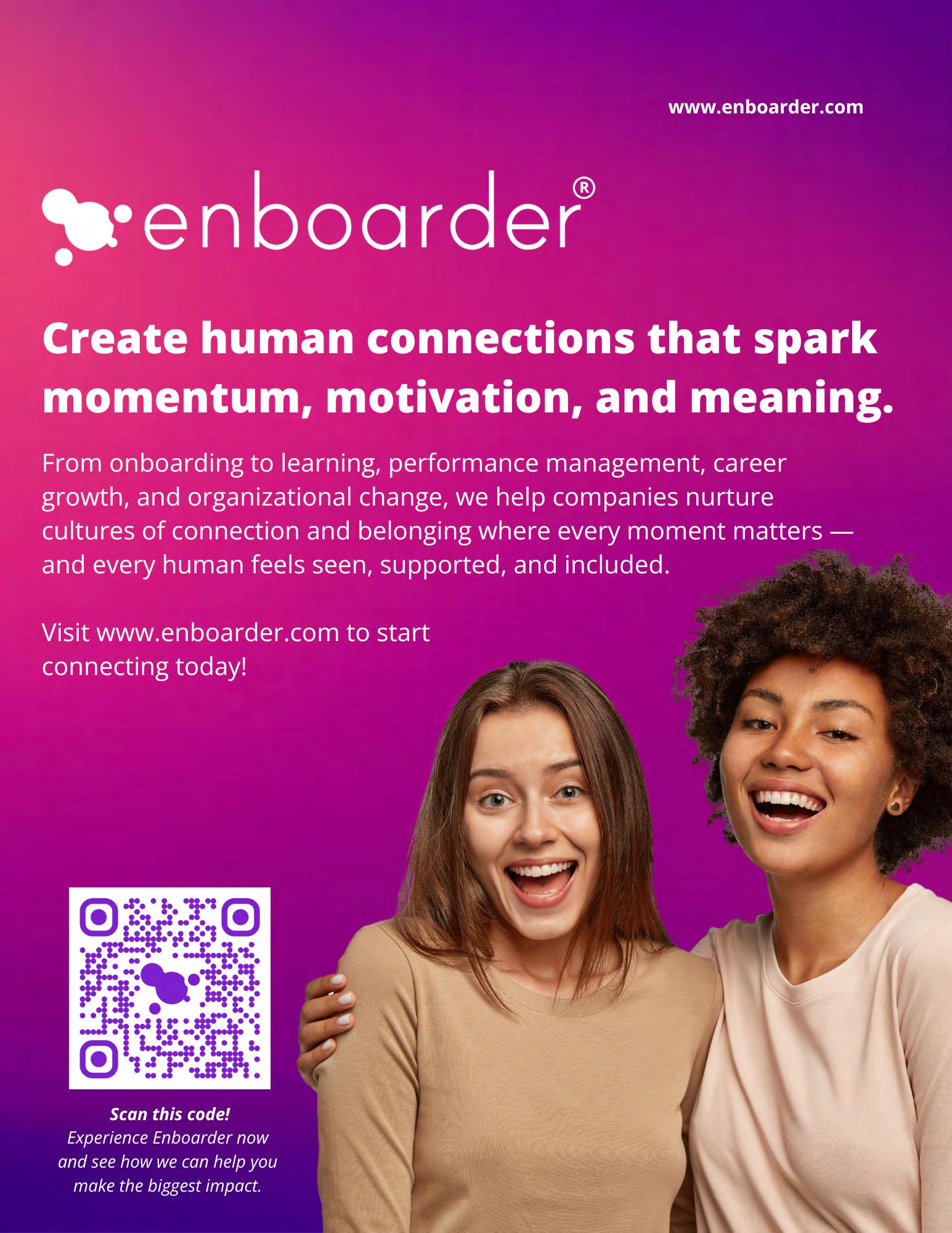
Fertility at work
A global report from Carrot Fertility

Fertility and family-forming journeys can be physically, emotionally, and financially challenging for many people worldwide. Infertility has become more common, with new data from the World Health Organization suggesting it impacts 1 in 6 people worldwide. On top of that, globally, there are laws and regulations that can make it significantly more difficult for people to access care.
Fertility is not only a global healthcare concern – it’s an important workplace issue. To better understand how fertility impacts the workplace, we surveyed 5,000 people across the U.S., UK, Canada, India, and Mexico. We asked questions to get a sense of how people around the world feel
about fertility topics at work and how they want to be supported in their fertility and family-forming journeys. Our results show that no matter where people live, many are facing fertility challenges, seeking support, and turning to their employers for help.

Pressure to build a family is universal
In addition to the personal desire to start or grow a family, the vast majority of people overall (91%) indicate they also feel societal pressure from at least one major source – most commonly a parent wanting to have grandchildren (49%). Spouses and religion are the second and third most common sources of pressure, respectively.
STATE OF THE INDUSTRY RESEARCH 28 ARTICLE
There was also a gender divide among respondents. Thirty-seven percent of women rate their age or the timing of building a family as their second most common source of pressure. Additionally, 36% say their country’s culture places a stigma on people experiencing infertility or fertility challenges, which can make it difficult to have open, honest conversations and find much-
Financial challenges are the biggest roadblock to starting a family
Respondents rank financial challenges as the most common roadblock to starting a family, reported by a majority in each country and 63% overall. Workplace challenges (55%), such as career growth considerations, are the second most common roadblock and are also experienced by a majority in each country.

needed support. For respondents in India and Mexico, this is even more prominent, with 50% of respondents from India and 42% of respondents from Mexico believing their culture places a stigma on people experiencing infertility or fertility challenges.

For employees looking to start or grow their families, just 32% say they can afford fertility treatments if needed. Twenty-nine percent say they may incur debt to pay for fertility treatment, and 39% would have to dip into savings to afford
it. Mexicans are most likely to have to incur debt or dip into savings, with 31% saying they’re actively saving. Alongside Mexican respondents, Indians are the most likely to currently be setting aside funds for potential future interventions such as in vitro fertilization.
Among respondents who may incur debt to pay or have to dip into savings to afford fertility treatment, bank loans are the top financing option, as reported by 47%.
Americans and Canadians would be more likely to take on a second job to help finance their fertility treatments.
STATE OF THE INDUSTRY RESEARCH 29 ARTICLE
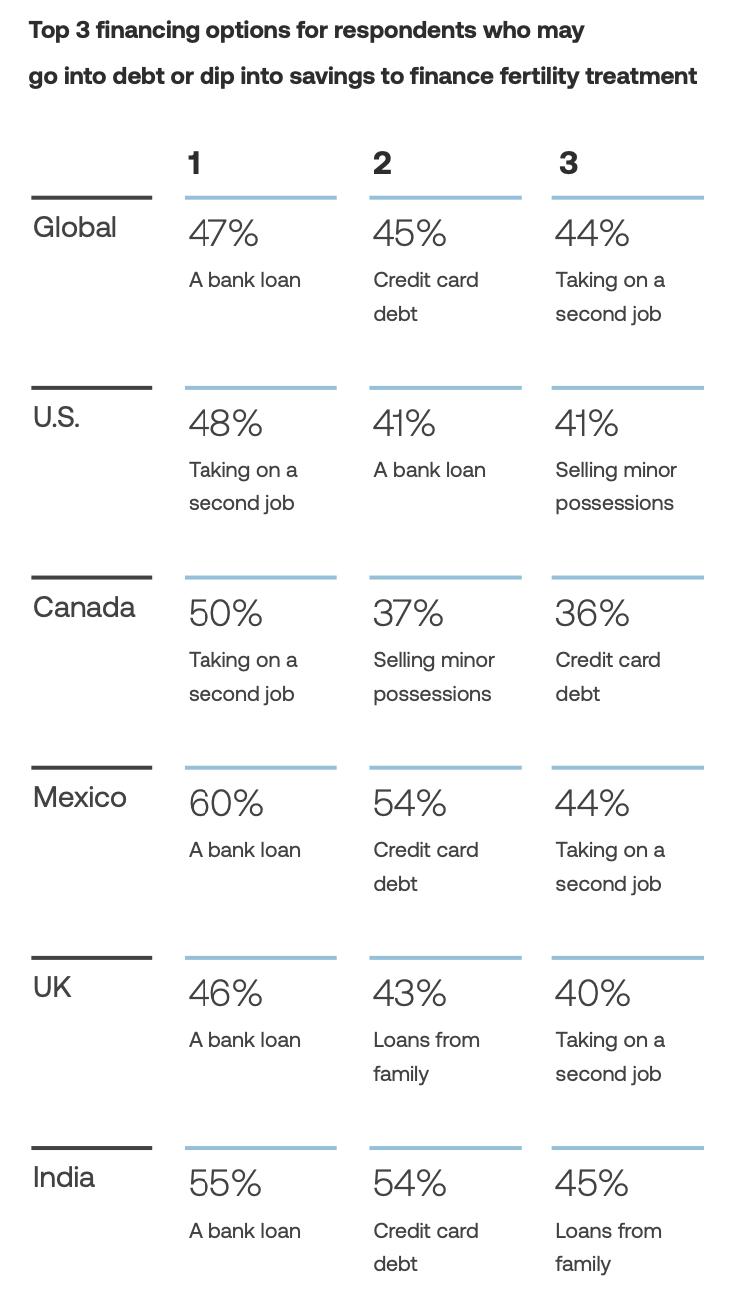

STATE OF THE INDUSTRY RESEARCH 30 ARTICLE
Fertility benefits are a crucial part of employee recruitment and retention

Fertility not only impacts people in their personal lives – it can also impact their work productivity and performance. Sixty-five percent of respondents say that they spent time at work researching fertility treatments, benefits, and family forming, and 55% share that fertility challenges have detrimentally impacted their work performance.

Fertility benefits are also an influential factor for people seeking new jobs. Sixty-five percent of respondents say they would ask about fertility benefits before accepting a new job offer and 42% even consider it to be a “deal breaker,” if not offered for a new job.
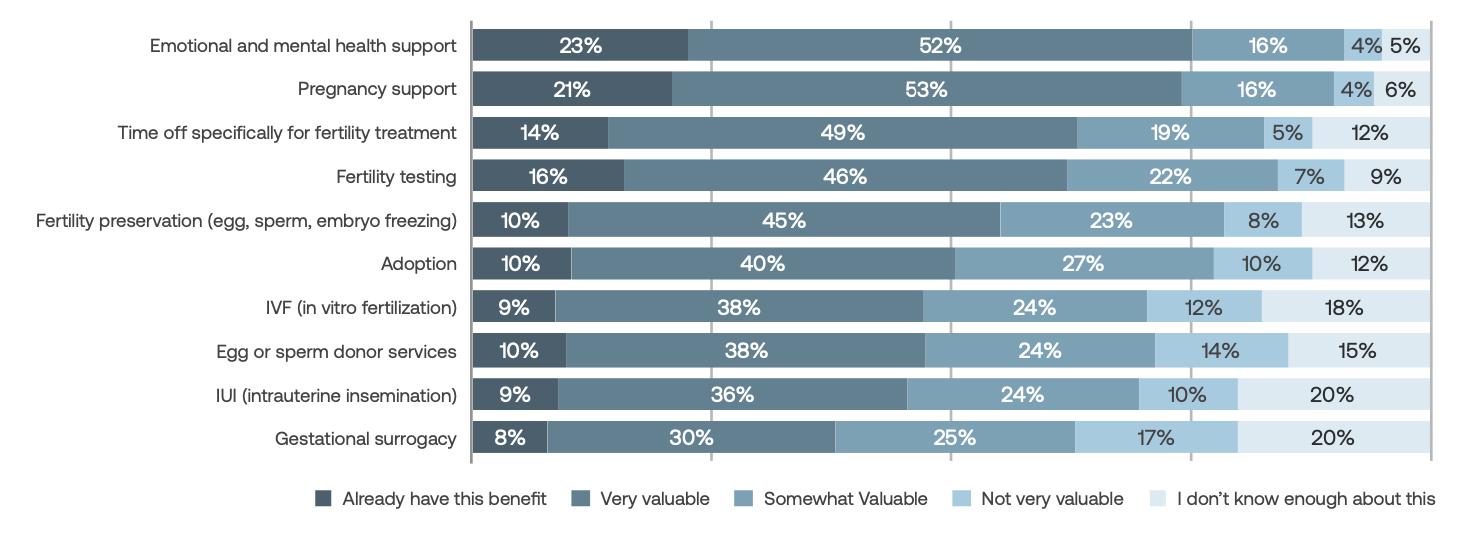
Please click here for the complete article.
Would you like to comment?
STATE OF THE INDUSTRY RESEARCH 31 ARTICLE

Embracing Flexibility, Possibility, and Humanity: Shaping the Future of Work
Jaime Faulkner, TTI Success Insights

In the constantly changing landscape of work, one thing remains at the core of every successful organization: its people Gartner Research shares that employees in human-centered workplaces were 3.2 times more likely to enjoy their work with a high intent to stay.
How can you build a human-centered workplace in the future? Focus on three areas: flexibility, possibility, and humanity.
Embracing Flexibility in the Workplace
Workplace flexibility means employees can choose how, where, and when they work. It supports wellbeing, develops work-life balance, and promotes higher levels of trust and engagement.
A prime example of workplace flexibility is the rise of remote work. Its increased popularity in the last few years gave workers a taste of a better-balanced life. It is no longer a trend; it’s a new expectation that workplaces must meet to remain competitive.
Providing flexibility in location is a massive benefit for everyone involved. It directly improves the lives of workers with disabilities by providing access and opportunity while supporting their needs. It also allows employers to fully explore the global talent pool and find the exact right person for the position without being compromised by location.
Flextime allows employees to adjust their daily work schedules to accommodate personal obligations and preferences, like picking up their children or taking time for medical appointments without using their PTO.
Forbes shared, "Workers with full schedule flexibility report 29% higher productivity and 53% greater ability to focus than workers with no ability to shift their schedule.”
Organizations should trust employees to manage themselves as long as they are getting their work done. Embracing flexibility promotes work-life harmony and reduces burnout in the long run.
Unlocking Possibility and Potential
Many companies say that they support innovation and experimentation but don’t follow up with their actions— if employees are too bogged down by heavy workloads to experiment, that will shut off potential avenues of progress before they can make any discoveries.
Providing space for experimentation and risk-taking will help teams pursue the best way to achieve tasks instead of simply accepting the status quo.
STATE OF THE INDUSTRY RESEARCH 33 ARTICLE
Another way to promote possibility is to make room for personal development. Encouraging training and upskilling opportunities will help employees to become confident and well-rounded. By attending webinars and workshops, pursuing additional certifications, and learning more about themselves through behavioral assessments, employees will develop their skills while feeling supported in their career development.
This approach also helps develop an internal talent pipeline. If leaders can help their workers move up in the organization by promoting from within, it will save on onboarding costs while investing internally.


Human-Centered Leadership
Ultimately, the future of work's success hinges on leadership strategy that prioritizes people above all else. Companies cannot treat human-centered
leadership like a buzzword or an afterthought; how you treat your employees will make or break your company’s future.
Focus on human-centered leadership by building strong relationships and trust. If you’re lucky enough to get honest feedback, act on it! Many organizations treat criticism as something to discard or cover-up, but the truth is that every piece of information received is valuable. Don’t waste employees’ honesty; act on their input and make the improvement process transparent by sharing progress.
Alongside that, encourage diverse perspectives and collaboration. If all decision-makers have similar backgrounds, identities, and experiences, the vision of their organization’s future might be limited to what they think is possible. Avoid the echo chamber!
STATE OF THE INDUSTRY RESEARCH 34 ARTICLE
Establish a clear diversity and inclusion policy by providing diversity training and education for staff members and supporting ERGs, or employee resource groups, to create connection and community for minorities in your organization. A solid diversity plan will help attract new talent while supporting current team members since NorthOne reports that 76% of candidates believe diversity is an essential factor to consider when evaluating a company,
The first step in implementing these changes is encouraging open dialogue and respectful communication. Explain company policies clearly and hold firm to those beliefs; your team will appreciate it.
What Impact Will These Strategies Have on Organizational Success?

Embracing flexibility, possibility, and humanity is the key to shaping the future of work and creating thriving organizations. The impacts on employee engagement, satisfaction, retention, recruitment,


productivity, and performance cannot be ignored. The future of work will directly lie on the people brave enough to guide it, and embracing these principles will not only shape a better future of work but also create organizations that thrive in an everevolving landscape.
Jaime Faulkner is a writer, editor, and storyteller based in Phoenix, Arizona. She believes authenticity and storytelling are the keys to successful marketing and specializes in uncovering the narrative of a business to share with its network. Jaime has worked as an editor and writer for literary magazines, small businesses, and organizations with an international audience and currently works as the Content Manager at TTI Success Insights, She has also managed social media strategy, voice and branding, and content creation for multiple businesses and nonprofits.
Would you like to comment?
STATE OF THE INDUSTRY RESEARCH 35 ARTICLE


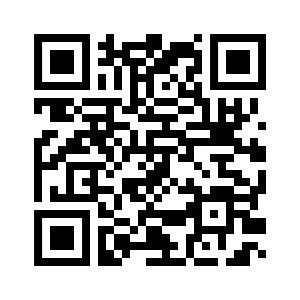

TTI Success Insights' Stress Assessment helps you understand where your team member is feeling pressure the most — and how to fix it. Human-Centered Leadership Scan this QR code to experience it first hand ©TTI Success Insights www.ttisi.com
people are the future of your business, you need to See them.
When
Developing a Connected Culture to Attract Talent, Retain Top Performers & Deliver Results
Tim Schieffer, ITA Group
The employee experience is broad, capturing the journey from job seeker to new hire to tenured employee. Given the employee journey’s ability to transcend a set timeframe, industry or employee demographic, it’s up to organizational leaders to make the journey feel driven by corporate goals and tailored to team members.
Organizations can elevate their current employee experience programs by leaning into a connected culture approach. With a connected culture, interactions between the company, executives, team and team members become more purposeful—and more likely to thrive.
Defining Connected Culture
A connected culture is a need-to-have for organizations that want to attract and retain talent. At a glance, here’s what you need to know:
What It Is: A corporate-wide approach that focuses on organizational alignment, a well-established culture, an appealing employer brand and strong leadership development.

Why It Matters: Effective development and implementation of a truly connected culture
attracts and retains talent, and improves organizational outcomes.
How It Impacts Employees: Connection helps employees feel valued and appreciated, spurring them to become brand advocates. Individuals who are more connected with their employer care more deeply about work they’re doing and are more successful in achieving the outcomes that matter most to them and their organization.
To maximize the value of a connected culture, organizations need to:
● Ensure leadership alignment, consistency and support
● Evolve and sustain employee experience efforts
● Put connected culture programs into a reinforcement cycle
Building Executive Team Alignment
Want to achieve a truly connected culture? Executive team alignment is critical. While it may sound obvious, if it were that simple, many organizations would already be operating high employee engagement levels, maximum efficiency and desired profitability.
STATE OF THE INDUSTRY RESEARCH 37 ARTICLE
To create c-suite level alignment, your executive team must have powerful, authentic, robust and transparent conversations, like discussing:
● The trajectory of influential organization decisions




















● Past misalignment that impacted communication or implementation of executive goals, and how it affected the organization, results and, potentially, customers




● How the team should (and will) work better together to communicate and remain aligned moving forward
There’s no one right way for executive teams to stay aligned. Here are a few ideas:
● Dedicated off-site strategic planning sessions









● Retreat-style get-togethers focused on
teambuilding and breaking down barriers
Give-back group opportunities to support an altruistic effort of serving the greater good



● Tailored experiential learning session focused on team dynamics and discovering insights
The bottom line: executive teams need to reflect on what strategy is right for their organization and what is going to truly foster alignment to remain effectively aligned.
Creating a Transformed Culture
While most executive teams recognize the impact of change as it affects their particular area of business or discipline, the influence of a corporate wide culture change is often less embraced— leaving better performance and increased profits on the table.

STATE OF THE INDUSTRY RESEARCH 38 ARTICLE
Organizations can’t realize the full potential of business transformation, or new ways of working, without supporting cultural change—seen in practice as organizational behaviors and norms.
A study by Boston Consulting Group reports that companies focused on culture and providing proper cultural support were five times more likely to achieve breakthrough results in their transformation initiatives than those that didn’t.
Want to be one of those companies? Recognize that culture change only happens with dedication. It’s challenging enough to change one’s own habits, not to mention, thousands of employees’.
Once the executive team is aligned and has defined the desired culture state, there are some best practices to keep in mind as the culture changes are put into action.
● Ensure executives are the face and voice of culture change
● Involve critical stakeholders early and have them understand why change is necessary
● Engage team members and gather feedback

● Build and communicate the culture road map
● Reinforce and reward desired culture shifts within the organization
Elevating Employer Branding
The employer brand is your company’s reputation, and it plays a vital role in retaining team members and attracting new talent. It also impacts the retention and attraction of customers. Each audience that buys into your brand ultimately leads to increasing revenue and reducing expenses.
Here are the key players that support a successful employer brand.
Human Resources: From to finding and hiring talent, engaging employees and maintaining retention, this team is the “face” of employer branding.
C-Suite Executives: As busy as the C-suite might be, they’re critical supporters and faces of culture change and employer branding, even talent acquition.
Marketing: This team works hand in hand with HR to uphold employer branding, from crafting and delivering value messaging that resonates with team members to promoting the brand and culture during recruitment efforts.
Brand Advocates: As with any cultural transformation, there have to be influential team members who share corporate messaging and endorse the culture. Identify these players to strengthen recruiting messages and improve the company’s reputation and culture to attract more top talent.
Being a part of an organization with a great work culture is uncompromisingly important to today’s job seekers, and companies need to be mindful of how they showcase that culture. If you have a solid employer brand, candidates are seeking you out. When done well, strong culture and employer branding reduces recruitment costs and leads to a greater selection of top talent.
Implementing Leadership Training
Strong leaders are in place to make the connected culture a reality.
STATE OF THE INDUSTRY RESEARCH 39 ARTICLE
According to the Bersin by Deloitte report HighImpact Leadership Development, organizations with stronger “leadership maturity” are:
● 11x more likely to have a high number of leaders who can build talent for competitive advantage
● 7x more likely to have a high number of leaders who can inspire people to follow them.
The same report indicates that capable leadership talent is rare. Only 60% of leaders show commercial acumen and business judgment; 48% are seen as driving change and innovation; and only 44% build talent for competitive advantage. This all points to the fact that organizations need strong leadership development solutions to maximize on their culture investment.
How do you do that effectively? Here’s a quick list of leadership development dos and don’ts from the Center for Creative Leadership.
Leadership Development Dos
● Treat leadership development as a process
● Incorporate best practices, data and personal stories into leadership learnings

● Connect leadership learnings with on-the-job challenges
Leadership Development Don’ts
● Consider leadership development as a one-and-done event
● Structure leadership learnings through a single approach
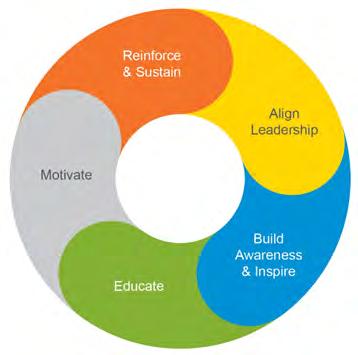
● Launch leadership learnings without previous executive buy-in or input
Reinforcing a Connected Culture Throughout Your Organization
A connected culture needs to be woven into every employee’s work journey in order to maximize their value and contribution. ITA Group helps employers implement a reinforcement engine to keep momentum with the good culture progress they’ve made.

Culture is a force multiplier for the outcomes that matter most to you and your organization. When your culture is truly connected, and you consistently reinforce the culture, it becomes a powerful differentiator.
Would you like to comment?
Tim Schieffer is Insights and Strategy Leader at ITA Group.
STATE OF THE INDUSTRY RESEARCH 40 ARTICLE
Motivate Employees to Do Their Best Work
ITA Group’s employee experience programs bring out the best in organizations and their people. Our tailored approach ensures that employees are supported throughout the employment journey, and feel celebrated and inspired. Attract and retain top talent, and maximize results when you meaningfully engage employees, no matter where they work or what jobs they do.
People Who Get Your People
Our engagement experts help HR leaders solve their unique needs with custom-crafted solutions.

> Recognition & Incentive Programs
> Service Anniversary & Milestone Award Programs
> Employer Branding & Employer Value Proposition Building
> Employee Communication & Engagement Campaigns
> Learning & Skills Development Programs
> Employee Events
MAKE THE MOST OF YOUR CULTURE INVESTMENT
Employee Experience | Events | Incentive Travel | Channel Partner Solutions | Customer Solutions

The State of Human Experience in the Workplace 2023 Human Experience Excellence • September 2023 For more information: 1.877.472.6648 sales@hr.com www.HR.com/epubs The HR Research Institute tracks human resources trends and best practices. Learn more at hr.com/featuredresearch Special Research Supplement
The Truth Behind The “Lazy Girl” Phenomenon
Employers must own their contribution to the #lazygirljob trend
By Ian White, ChartHop
Anew term has recently gone viral, describing the trend of Gen Z employees opting to prioritize a work-life balance — and quality of life — over career advancement and work commitments: The “Lazy Girl job.” But let’s think about this label for a minute.
It refers to flexible jobs that don’t suck away every waking minute with an always-on burnout culture. These jobs offer livable salaries and chill bosses, allow workers to prioritize mental and physical health, and ultimately offer a true work-life balance.
Depending on your perspective, you might view this trend as the ideal job and the future of work, or the entitled complaints of a disengaged generation, or somewhere in between. There’s nothing like a viral hashtag stirring up people’s preconceived notions.
But there’s something missing from this conversation: accountability from employers.
How Organizations Contributed to the “Lazy Girl” Trend
A cynical person might ascribe the lazy girl trend to a generation of workers who simply don’t want to work. But it’s not that at all. What if we look at this trend from a different perspective — a desire for balance - yes, but also the need for employers to care about their employees’ well-being (which many jobs lack)?
Belonging, growth, rewards, and validation matter. When employees feel happy, engaged, supported,
and valued, they’re remarkably more balanced and productive. If any organization is worried about this trend and finds itself complaining about these “lazy” Gen-Zers, it’s time to look in the mirror at its own culture and recognition system.
When employees give their all and continually show their dedication but never receive acknowledgment or recognition or rarely get rewarded fairly, disengagement shouldn’t come as a surprise.
Perhaps it’s time to see the Lazy Girl job trend as a desire for balance — not laziness. And if that trend isn’t reason enough for a closer examination of an employer’s culture, consider this: Companies with highly engaged workforces are 21% more profitable than those with disengaged personnel. Happier employees are also 12% more productive than those who aren’t.
Champion a People-First Culture
Is the idea of keeping employees “happy” somewhat antiquated? Yes, and we could argue it’s also irrelevant. After all, happiness isn’t sustainable 100% of the time in our personal lives or in the workplace. However, by embracing strategies that offer employees engagement opportunities, they’re more likely to enjoy their work — and their colleagues — and take pleasure in knowing they’ve made meaningful contributions in their roles.
Human Experience Excellence presented by HR.com September 2023 43 Submit Your Articles
TOP PICK
Engagement can take many different forms within companies through external professional development, coaching, and mentoring. It might include a system for employee-led teaching and professional development. Leadership might promote departmental cross-collaboration and use data-rich organizational charts to facilitate company-wide connections.
Consider these other strategies for championing, celebrating, and incorporating engagement into your company.
1. Conduct continuous performance reviews
Organizations prioritizing development with consistent manager feedback and training opportunities also experience higher levels of employee engagement and satisfaction. If you haven’t already, create a process to conduct continuous, fair performance reviews.
Establish regular feedback channels, set performance expectations, and provide real-time insights. Continuous performance management allows you to evaluate individual employees’ performances with more regularity. Consistent 1:1s held weekly, bi-weekly, or monthly cultivate trust between managers and their direct reports — an approach that also helps develop a common culture. These 1:1s also ensure visibility into ongoing collaboration and projects, current tasks, and professional growth initiatives.
2. Celebrate and reward successes and milestones
Everyone loves a success story — and big or small, acknowledging a job well done can bring a smile to someone’s face. Use Slack or another instant messaging program to highlight team wins and recognize individual milestones and accomplishments. Send a birthday card from the C-suite and a group digital card.
3. Promote transparency
A Harvard Business Review study found that 70% of employees are more engaged when their leadership regularly updates everyone about organizational strategy. Clearly, companies can’t afford not to champion transparency. In addition to providing regular company-wide updates, leadership should explain the why behind decisions, which is respectful to employees and holds everyone accountable.
Advocate for transparency with pay — and align compensation with industry standards. Salary transparency might include sharing pay ranges for each role and explaining how salaries are calculated. With increasing legislation driving pay transparency, now is an excellent time to ensure your company communicates information appropriately with current and potential employees.
Defining How Engagement Looks at Your Company
Employee engagement looks different according to the individual, team, or organization. Defining what it looks like creates a foundation to view, analyze, and understand engagement data — and helps align everyone, from top to bottom, going forward.
A people operations platform collects and measures engagement and employee morale data to provide insight into how employees are doing on a personal, departmental, and company-wide level. The information helps leadership create decision-based responses. And the platform can even help identify which data to collect. With these metrics, leadership can level-set expectations or execute problem-solving processes that put employees first.

Human Experience Excellence presented by HR.com September 2023 44 Submit Your Articles
The Truth Behind The “Lazy Girl” Phenomenon
Do you want engaged employees? Show them how they’re valued at your company. Gen Z values authenticity, flexibility, transparency, and a positive work environment. Shouldn’t those be the ideals to which all companies aspire?

Companies giving their people freedom and responsibility, trusting them to complete their work,
and holding them accountable to high standards are less likely to see their employees disengage and embrace the Lazy Girl (or Lazy Guy or Lazy They) Job phenomenon. While this trend reflects, in part, an understandable desire for balance, it also highlights the critical need for employers to care about their employees’ happiness, satisfaction, and well-being.
Ian White is the CEO, CTO, and Founder of ChartHop, a People Operations Platform. Previously, he was the Founder and CTO of Sailthru. Before that, Ian was the first head of engineering at Business Insider and built the publishing platform that powers today’s highest-trafficked business website.
Would you like to

comment?
Human Experience Excellence presented by HR.com September 2023 45 Submit Your Articles
The Truth Behind The “Lazy Girl” Phenomenon
Employee Engagement In The Digital Era: Communication Strategies To Engage All Generations Of Workers
Unlocking employee loyalty through inclusive language and mentorship programs
By Dr. Laurie Moroco, Lauriemoroco.com
It’s no secret that the current workforce is the most diverse one in history. Thanks to a combination of DEI (diversity, equity, and inclusivity) efforts finally taking root, different levels of formal education, and five generations all under one roof. Yet, trying to manage and lead all these beautifully unique individuals requires excellent communication.
In today’s job market, and with the Great Resignation finally slowing down, it’s important to engage your employees and keep them happy. As an human resources (HR) professional, your primary goal is to keep and attract top talent — no matter who (or where) they are.
Tailor Your Communication
There are many different ways to communicate with your workforce, including sending emails or instant messages, having face-to-face conversations, or
making phone or Zoom calls. What’s important is that you’re providing different methods of communication to your employees.
The easiest way to determine how to best communicate with your employees is to simply ask them. Send out a survey or have an informal conversation when you check in with them — you might be surprised how each person knows exactly what they want. You can also take a step back and observe your workforce and see how they communicate with others.
The Silent Generation and Baby Boomers, for instance, tend to prefer talking face-to-face or calling if they’re remote, whereas Generation X prefers phone calls or video meetings, and Millennials and Generation Z largely prefer instant messaging. Interestingly, for more formal communication, most of the generations prefer email.
Human Experience Excellence presented by HR.com September 2023 46 Submit Your Articles
By sending a survey, you can determine the best way to relay information to everyone in your company. Having different modes of communication allows for personalization. For example, when sharing a major shift in the company — such as a shift in employee roles — you can share it in a company-wide meeting both in person and online if you have a hybrid workforce. You can also share it in an email highlighting key points, as well as through an instant message platform if your company uses one. This ensures everyone receives the message and is receiving it how they prefer.

The key to communication is accommodation. It’s not about working harder to fit everyone in but about making it common practice to tailor communication to ensure that everyone feels included and heard.
Inclusive Communication
Other than offering different modes of communication, it’s important to incorporate inclusive
language. It should go without saying that when communicating with employees, you should avoid slang and keep it professional, as this helps promote inclusivity and also ensures that no one feels left out for not knowing the latest slang word.
Inclusive communication also includes removing generalizations and social biases from your language. HR professionals know that unconscious biases are very real, and they can have a huge impact on everyone’s work lives.
As an HR leader in your organization, it’s crucial to be aware of your own biases and how they might affect others. Examine your own behaviors and assumptions, and provide professional guidance to your company if it’s necessary. Some people may resist, but it’s important to remember that unconscious biases don’t make anyone a “bad person” — they are simply a product of upbringing and experiences.
Human Experience Excellence presented by HR.com September 2023 47 Submit Your Articles
Employee Engagement In The Digital Era: Communication Strategies To Engage All Generations Of Workers
Providing an inclusive environment and treating everyone as humans will strengthen your workforce and continue to attract talented individuals to your company. In addition, it provides a highly engaged workforce that will actively work toward company goals.
Mentor and Mentee Collaboration
Whenever possible, HR leaders should bring together employees from across generations to deliver inclusive and integrated messaging. If different generations of workers only meet with each other, rather than their peers from other generations, silos can form and lead to division and misalignment. Each generation has a lot to teach others, and supporting a multigenerational environment can strengthen company culture.
Incorporating a mentorship program in your company can promote different generations talking to each other and have each one teach the other important skills. For example, older generations can share their knowledge and experience with younger generations, and younger generations can teach older generations how to efficiently use technology or keep them up-to-date on the latest technology in their company.
Whether it’s different generations, ethnicities, or even genders, accommodations should be at the forefront of communicating to your workforce. Individualization is key to increasing engagement among your
employees because it shows you care and helps them feel heard and acknowledged. Gone are the days in which one-size-fits-all and it’s all about working together to increase productivity and satisfaction in the workplace.
In the digital era, communication is no longer a one-way street. By using a variety of communication channels, tailoring your communication to different generations, and being clear, concise, personal, transparent, and listening to feedback, you can engage all employees and create a more productive and positive work environment.

Dr. Laurie Moroco has always been an advocate of competent and effective communication, which she believes equips people with tools for successful personal and professional relationships. She was a solopreneur who achieved success when her chocolate-covered handmade treats appeared on the Rachel Ray show and at the Republican National Convention. Her businesses have been featured on MSN and Working Mother.
Would you like to comment?

Human Experience Excellence presented by HR.com September 2023 48 Submit Your Articles
Employee Engagement In The Digital Era: Communication Strategies To Engage All Generations Of Workers

ePublication EditorialCalendar2023 Checkoutthenewandupcomingthemed HRtopicsinHumanExperienceExcellence -Engagement,Performance,Rewards &Recognition Check ePublications Editorial Calendar Here. Would you like to submit an article? | Write to us at ePubEditors@hr.com Submission Guidelines 1 Best Practices in Gathering and Encouraging Employee Feedback Oct 2023 2 The Future of Employee Engagement Nov 2023 3 Workspaces of the Future Dec 2023
Engaging Employees & Building Connections Amid Changing Trends And Economic Uncertainty
 By Brenda Pohlman, Workhuman
By Brenda Pohlman, Workhuman
Amid talks of an economic downturn, budget cuts, and upheavals in the financial sector, there has been plenty keeping
human resources (HR) leaders up at night so far in 2023. With shifts in the employer-employee dynamic, the rise of remote and
hybrid work, and a general demand for workplace flexibility, many HR leaders are finding the same tactics that helped retain talent before the pandemic no longer apply in today’s workplace.
Managing people through these changing times requires paying extra attention to what they need and what they are saying. Based on various reports that will be outlined below, it is evident that workers want to have a sense of genuine connection with their coworkers, and there are a few strategies HR leaders can embrace to cultivate connection throughout their workplace.
Human Experience Excellence presented by HR.com September 2023 50 Submit Your Articles
Five trends HR pros need to know about – they all point to a need to foster connection
TOP PICK
Economic Stress Is Weighing on Workers
While inflation is slowly coming down, it’s still persistently above what it has been over the past decades. As the Federal Reserve continues interest rate increases, many companies might be bracing for an economic downturn. With this in mind, finance-related stressors are having a powerful impact on employees, as 59.4% of workers reported being “slightly more” to “much more” stressed as a result of economic uncertainty, according to Workhuman’s Human Workplace Index.
When HR leaders and managers have a good grasp on how employees are feeling, they can play a major role in helping combat escalating stress levels and prevent burnout. A key way to achieve this is through consistent engagement with
employees. Regular employee surveys and town halls, especially during uncertain times, not only provide an opportunity to engage with workers but also shed light on how they are feeling at any given time, providing a platform for them to be heard. However, it’s important to demonstrate to employees how their responses make a difference by closing the feedback loop and taking action accordingly. These steps can help create a truly harmonious workplace where workers feel that their concerns are being recognized and addressed.
Employees Don’t Feel Valued
Whether you call it “quiet quitting” or any other trending buzzwords du jour, employees are disengaged, disconnected, and feeling invisible. Research from Workhuman shows that nearly
30% of workers have felt unheard at work, 27% have felt completely ignored, 23.4% have felt shut out of conversations, and 21.9% have felt invisible. The result often leads to the creation of a disconnected workforce that is concerned about their position in the workplace.
Feeling seen, visible, and valued is crucial to employee productivity and engagement, which, in turn, leads to better business outcomes. To feel seen at work, half of respondents want recognition for achievements, and three in ten suggested making leadership more available to employees. In order to foster workplace engagement and ensure they’re creating an environment where everyone feels seen and valued, leaders should start actively giving credit where it is due.

Human Experience Excellence presented by HR.com September 2023 51 Submit Your Articles Engaging Employees & Building Connections Amid Changing Trends And Economic Uncertainty
Bias in the Workplace Remains a Problem
While we have come a long way in making progress in gender equality, nothing shows that there is more to be done than the gender pay gap. In the last two decades, the gender pay gap has barely closed— the Pew Research Center reports that in 2022, women, on average, earned 82 cents for every dollar earned by men, while in 2002, that figure was 80 cents on the dollar. Women may face barriers to advancement, such as being passed over for promotions or not being given the same opportunities as their male counterparts. This presents a serious problem for psychological safety for women and feelings of disempowerment.
HR leaders can best address this issue by leveraging the data available to them, like diversity analytics and pay equity reviews. One of the perks of a robust employee recognition program is the ability to identify where equity gaps lie in your organization. Through elevated analytics, where leaders can track which employees haven’t received recognition, differences in the monetary value of recognition given, and even if there is disparity, a difference in language used to acknowledge colleagues, organizations can address underlying issues and meaningfully measure progress. From this, leaders can tailor and modify their strategies accordingly to eliminate bias in
the workplace and, in doing so, create an environment where workers feel safe to genuinely engage with each other.
Leaders Need to Walk the Walk on DEI Promises
Another trend emerging in headlines across industries is the disconnect between management and workers when it comes to diversity, equity, and inclusivity (DEI) efforts. Many companies made pledges and set strategies in the summer of 2020 to address DEI shortfalls— but years later, progress seems to have stalled. Data from job marketplace Hired revealed that the wage gap in tech between white men and most of their counterparts in underrepresented groups widened between 2021 and 2022. For example, Black women in the technology industry made 90 cents on the dollar compared to white men in 2022— two cents less than they did in 2021.
There is clearly a disconnect between what was being said and what was being done. To solve for biases in the workplace related not only to pay inequality but every kind of inequality, management and workers need to be in sync. Leaders are crucial to cultivating a more diverse and inclusive workplace as they set the tone for an organization’s culture and build morale for those they manage. For instance, employers should keep everyone in the loop on DEI efforts, explaining any challenges they see and how they plan to overcome them. After all, overcoming biases in the
workplace requires reinforcing inclusive behavior and genuine buy-in from everyone.
Camaraderie Is Key to Building a Connection
A survey by Gallup found that employees who have high-quality recognition experiences are up to seven times as likely to strongly agree that they have meaningful connections or a best friend at work, and as much as ten times as likely to strongly agree that they belong. Further, those who’ve experienced a lot of gratitude the previous day are up to four times as likely to strongly agree that their organization cares about their well-being.
Workplace friendship is essential in creating a positive company culture. It boosts productivity, improves job satisfaction, promotes teamwork, and creates a sense of belonging. HR leaders can help facilitate this connection by encouraging workplace friendships through establishing a buddy system, hosting social events and team-building activities, and encouraging peer recognition, for instance. The Gallup data shows clearly that employees who have a best friend at work are significantly more likely to engage customers and internal partners, get more done in less time, innovate and share ideas, and, in general, have fun while at work. This type of support is all the more crucial in the post-pandemic workplace, where many employees are more emotionally taxed and physically distanced.
Human Experience Excellence presented by HR.com September 2023 52 Submit Your Articles
Engaging Employees & Building Connections Amid Changing Trends And Economic Uncertainty
Time to Make Your Workplace Conducive to Building Connections
Research shows that the key threads to a positive workplace are connection and trust. Leaders should actively and regularly celebrate personal and professional wins of their team members, motivate employees to recognize achievements and call
out successes in real time. This empowers employees to be active participants in the workplace culture, leading to higher satisfaction and lower turnover. By investing in specialized peer recognition tools, employees can easily express and receive appreciation, cultivating a sense of belonging, strengthening connections, alleviating loneliness, and enhancing productivity.
It’s time for leaders to start listening to their workers, understand how they can show up for them, and acknowledge that each employee has unique needs. When leaders create a work environment conducive to building genuine bonds, employee engagement, motivation, and well-being, all improve as there will be true buy-in from everyone.
Brenda Pohlman serves as a Practice Leader at Workhuman, where she leads a team of consultants working with global customers on innovative strategies for creating more human workplaces. The team is instrumental in launching successful culture and talent initiatives with some of the largest and most admired organizations in the world. While Brenda’s day-to-day focus is on supporting her team’s success, nothing energizes her more than engaging with customers in conversations about the power of social recognition to drive business results. Her career spans 25 years in human capital management, with a focus on employee engagement, talent management, and rewards and recognition.
Would you like to comment?

Human Experience Excellence presented by HR.com September 2023 53 Submit Your Articles
Engaging Employees & Building Connections Amid Changing Trends And Economic Uncertainty
HRCI® & SHRM® CERTIFICATION PREP COURSES
GROUP RATES AVAILABLE
For HR Professionals
Show that management values the importance of the HR function, and has a commitment to development and improvement of HR staff.
Ensure that each person in your HR department has a standard and consistent understanding of policies, procedures, and regulations.
Place your HR team in a certification program as a rewarding team building achievement.
For Your Organization
Certified HR professionals help companies avoid risk by understanding compliance, laws, and regulations to properly manage your workforce.
HR Professionals lead employee engagement and development programs saving the company money through lower turnover and greater productivity and engagement.
A skilled HR professional can track important KPIs for the organization to make a major impact on strategic decisions and objectives, including: succession planning, staffing, and forecasting.
HR.com/prepcourse CALL TODAY TO FIND OUT MORE 1.877.472.6648 ext. 3 | sales@hr.com
Why Certification is the Best Choice:
1 Less expensive than a masters or PhD program, and very manageable to prepare with flexible study options.
2. Recertification - ensures HR professionals continue to be up to speed on the latest legislation and best practices
3. Recognized, Industry benchmark, held by 500,000+ HR Professionals
Group Rate Options
We offer group rates for teams of 5+ or more for our regularly scheduled PHR/SPHR/ SHRM or aPHR courses.
For groups of 12+, we can design a more customized experience that meets your organization’s needs. You can have scheduling flexibility in terms of the days, times, and overall length of the course.
Groups rates for HRCI exams are also available as an add-on.
All group purchases come with 1 year of HR Prime membership for each attendee to gain the tools and updates needed to stay informed and compliant.

CALL TODAY TO FIND OUT MORE 1.877.472.6648 ext. 3 | sales@hr.com | HR.com/prepcourse
1 2 3
How To Help Employees Offset Inflation—And Earn Lasting Loyalty In The Process
Enhancing employee engagement through smart incentives
By Marina Hodges, Blackhawk Network
Asbusiness and human resources (HR)leaders are keenly aware, today’s business landscape is in a volatile state, with some unique and dire workplacerelated challenges. But people are also experiencing challenges in their personal lives. Given all that’s going on with the economy, it’s no surprise new research[1] found that an astounding 97% of people surveyed are deeply concerned about the rising cost of inflation. While on the surface, it appears employers have the upper hand in the tightening job market, additional research[2] has found that nearly 75% of employed respondents are seeking new employment, and almost 90% have reported concerns about their employment.
You may have a full workforce roster and better access to job candidates now compared to the last few years, but your current employees are incredibly distracted, which could be leading to workplace apathy (e.g., quiet quitting), low productivity, and mediocre engagement. Meeting this situation head-on with a thoughtful approach is a must if you’re trying to positively impact the long-term health (and maybe even short-term survival) of your business.
Don’t Panic—There’s a Solution Well Within Your Grasp
Although a significant number of respondents reported being unhappy and seeking out new employment, research[2] found about one-third would be more loyal to an employer if they received benefits to help manage inflation, and nearly a quarter would appreciate more frequent recognition for their contributions and achievements.
Many organizations are tightening budgets, and large raises aren’t feasible, which is even more reason why now’s the time to examine and refresh your rewards and recognition programs. This will help you better retain and engage top talent (preventing expensive recruiting, onboarding, and training costs) while also advocating for your employees and alleviating some of their economic concerns in a cost-effective and efficient manner.
Showing your employees you understand what they’re up against can be an incredibly strategic, long-term business decision. And you already have access to a tool that will help you be successful.
Human Experience Excellence presented by HR.com September 2023 56 Submit Your Articles
Gift Cards: The Unexpected and Universally Available Panacea
Research[1] found that 61% of consumers are adapting their shopping habits to navigate inflation, and one-third are relying on gift cards to manage and control their budgets. Since they’re so versatile, gift cards are widely accepted and prevent people from having to take on credit card debt or risk debit overdraft fees. Considering U.S. credit card debt just topped $1T and the average U.S. consumer is carrying nearly $6K in credit card debt, any financial resources you can offer your employees will be game changers— and very much appreciated.
Since people are already seeking out gift cards on their own, save yourself the R&D (research & development) hassle and imperfect speculation trying to guess what they want; here’s how you can leverage gift cards for optimal impact:
● Help with the grocery shopping. Research[2] found that more than two-thirds of consumers are concerned about grocery and food prices. While large bonuses may not be within your budget, a meaningful spot bonus or reward
to help with employees’ grocery bills will be particularly useful.

● Reach your workforce no matter where they are. The global workforce is more spread out than ever, but gift cards are ubiquitous go-to spending tools across the world. Technology exists through widely used software tools like Microsoft Teams, where businesses and managers can disburse digital rewards to individuals or teams in mere moments. And there’s a nice added perk for digital gift card rewards: they don’t require shipping, and you can keep costs down to protect your bottom line.
● Let people give each other gift card rewards. The research[3] found that 81% of respondents would be interested in using a platform that empowers them to send and receive recognition to anyone in their company, and three-quarters want to be recognized by their colleagues. Considering gift cards are a go-to choice for personal gifting[1], carrying the trend over to the workplace is a seamless and clever transition to engage employees.
Human Experience Excellence presented by HR.com September 2023 57 Submit Your Articles How To Help Employees Offset Inflation—And Earn Lasting Loyalty In The Process
● Relate to younger generations. Gen Z and millennials are at the forefront of embracing gift cards[1] as spending tools, and you can leverage this trend to enhance engagement initiatives among these younger generations that have staying power within the workforce. Less-seasoned employees are likely not at the top of your company’s salary brackets, so the added monetary benefit will be especially impactful.
● Explore commuting stipends. In addition to being concerned about food and grocery costs, nearly half of survey[2] respondents are concerned about gas and fuel prices. Businesses with in-person or hybrid workplace arrangements can stand to benefit most from this strategy—as can their employees. Even a monthly stipend on a reloadable gift card would go a long way, particularly as return-to-office policies and remote work preferences continue to be hot-button issues.
● Don’t overlook the upcoming holidays. A research from last winter’s holiday gifting season[4] found that 84% of respondents wanted prepaid and gift cards from their employers— beating out all other options, including additional vacation days, food, and physical gifts. 70% of the respondents reported wanting cards because they enable people choice in what they buy—which could be something they need to offset inflation or something they wouldn’t normally splurge on (like a shopping spree or dinner out). Your employees have needs, and they have wants, and gift card rewards solve for both.
Ready, Set, Go!
There is, and will continue to be, substantial pressure on employers to provide relief to employees as economic challenges remain at the forefront of peoples’ minds across the globe. Fiscally responsible, smart businesses can lean on gift cards as incremental rewards and tokens of appreciation to offset the cost of living. Gift card rewards are easy to work into existing programs needing to pivot and
can also be easily implemented into new programs. Not only will understanding the power of numerous applications for gift card rewards help engage and retain your existing workforce, but it will also serve to be a competitive differentiator for other top talent if you’re looking to hire. Now’s the time to invest in your most valuable resources (your employees) even as you and other businesses feel economic strain.
Footnotes
[1] BHN’s “2023 Global Gifting Study” is based on the findings of an internet-based survey conducted by Grassroots on behalf of BHN between February 3–8, 2023. The sample size included 2,000 U.S. respondents ages 18+.
[2] “Employee Appreciation 2.0” is an internet-based survey conducted by Survey Monkey on behalf of Blackhawk Network (BHN) between March 1 and 2, 2023. The sample size included 1,257 U.S. respondents ages 18+.
[3] “Workplace Arrangements, Rewards, and Engagement Survey” is an internet-based survey conducted by Survey Monkey on behalf of BHN between February 25, 2022, and March 1, 2022. The sample size included 3,278 U.S. respondents ages 18+.
[4] “Blackhawk Network 2022 Holiday Forecast Study” was a study conducted by Leger on behalf of Blackhawk Network in August 2022. The sample size included 2,001 U.S. consumers ages 18+.
Marina Hodges is the Senior Director and Head of Incentives Marketing at Blackhawk Network (BHN). She has over 25 years of experience in financial services, investor relations, analytics, pricing, healthcare, compliance, and treasury.
Would you like to comment?

Human Experience Excellence presented by HR.com September 2023 58 Submit Your Articles How To Help Employees Offset Inflation—And Earn Lasting Loyalty In The Process
10 Steps For Managers To Transform Workplace Mistakes Into Opportunities
From missteps to milestones
By Shiela Mie Legaspi, Cyberbacker Inc.
The best managers always want to foster an environment of support and understanding for their employees. Employees shouldn’t fear making mistakes but know that they will have support from leadership in working through those mistakes and learning from them. With proper support from managers, employees are better equipped to navigate the complexities of challenges and emerge stronger.

How can managers turn mistakes into opportunities? Here are ten steps toward making the most out of the missteps and challenges that are bound to come as you build your business.
Within any workplace, mistakes are inevitable. Employees, managers, and CEOs are human, after all. However, mistakes can be turned into opportunities if one’s mindset and business approach are managed correctly. Mistakes, challenging hurdles, and emotionally charged situations can give leaders the opportunity to help employees grow and ultimately improve the business.
1. Approach with a Solutions-Oriented Mindset
Any mistakes or challenges should be approached with solutions in mind. It is not productive to simply belabor the point that a mistake has been made. Acknowledge the mistake or challenge, and then work to find viable solutions to solve the problem or fix the mistake.
Human Experience Excellence presented by HR.com September 2023 59 Submit Your Articles
TOP
PICK
2. Listen Actively
Many people listen to respond. However, listening actively involves truly hearing what the other person is saying and understanding the whole message before responding. In the case of mistakes or challenges, active listening is very important. To get to the bottom of how a mistake occurred, the mindset of the person making the mistake, and how to move forward, one must listen actively.
3. Avoid the Blame Game
Looking to point fingers is rarely productive in a situation where a mistake has been made. If you have cultivated a business environment where people feel comfortable, supported, and respected, the person behind the mistake will likely own up to it; there will be no need for blame.
4. Identify the Root Challenges
Challenges or mistakes within a business environment rarely come out of nowhere or are isolated incidents. There are typically root challenges that lead to larger issues. With risk analysis and open communication, these root challenges can be identified and rectified before they become larger issues.
5. Ask Open-Ended Questions
Open-ended questions allow the opportunity to gather more information and insight into a situation. The questions are open-ended because the responses are limitless, and leaders can gather as much information about mistakes or challenges as possible.
6. Offer Encouragement and Constructive Insights
When discussing any mistakes or challenges with employees, remember the platform of support and psychological safety that leaders should build their organizational base around. Leaders should offer encouragement and constructive feedback to employees so they can take lessons from the experience and apply them.
7. Collaborate on Solutions
Leaders should allow employees who have faced the challenges first-hand or participated in the mistake
to collaborate with them on finding solutions to the issues. This way, when faced with a similar situation, the employee will know how to better approach it.
8. Set Realistic and Specific Goals for Improvement
Sometimes multiple mistakes can be made, or an employee may face multiple challenges where an improvement plan needs to be discussed. These performance improvement plans should be realistic for the employee to achieve, and the goals should be specific — and written down.
9. Monitor Progress and Adjust as Needed
When improvement plans have been put into place or solutions have been brainstormed and applied, leadership cannot, just then, abandon the issue and believe all is well. Progress needs to be monitored, and adjustments should be made as needed.
10. Recognize and Reward Success
Just as progress needs to be monitored, so must success. When improvements are made or solutions are developed and successfully implemented, this must be acknowledged. Recognizing success is part of building a supportive workplace culture where people do not come to work, fearing that any mistake will spell the end of their careers.

As stated, mistakes are going to happen — it’s human nature. With a solid plan to acknowledge mistakes, brainstorm solutions, and remain supportive, employees can grow from mistakes and challenges and bring their best to their roles in the workplace.
Would you like to comment?
Human Experience Excellence presented by HR.com September 2023 60 Submit Your Articles
10 Steps For Managers To Transform Workplace Mistakes Into Opportunities
Shiela Mie Legaspi is the President of Cyberbacker Inc.
The State of People Analytics
September 20 2023
September 27 2023
REGISTER
October 4 2023
REGISTER
Sep 19 2023
The New Talent Goldmine is Global: Top Tips from Two Super-Recruiters
PM
Diversity Culture: How to Bring Psychological Safety to the Workplace
Where You Work Matters: Getting Payroll Tax Compliance Right for Remote and Hybrid Workers
-
PM
Sep 21 2023
1:00
2:00
PM
Sep 20 2023 VIRTUAL EVENTS & HR.COM WEBCASTS UPCOMING www.hr.com/upcoming_webcasts
2:00 PM
3:00
ET REGISTER
-
PM
11:00
12:00
ET REGISTER
AM -
11:00 AM
12:00
Supercharge HR with Generative AI: New Operating Models for Strategic Business Partnering ET REGISTER
www.hr.com/virtualconferences
View our Upcoming Webcasts Schedule and Register Today!
View our Upcoming Virtual Conference Schedule and Register Today!
ET REGISTER
Sep 26 2023
PM -
12:00 PM - 1:00 PM ET REGISTER
The Focus of DEI - A Business Imperative Sep 27 2023
WEBCASTS
REGISTER
10 Tips to Improve the Quality of Hiring
The Future of Diversity, Equity, Inclusion and Belonging
VIRTUAL EVENTS
Thank you for partnering with us!
Paycom (NYSE:PAYC) offers cloud-based human capital management software to help businesses streamline employment processes, from recruitment to retirement. With a robust suite of products including payroll, time and labor management.

LEARN MORE
You find the talent, we provide the platform that enables you to hire, onboard, manage compliance & pay global talent in over 160 countries.
LEARN MORE
THANK YOU
Jobvite is a comprehensive talent acquisition suite that powers a marketing-inspired recruiting approach from first look to first day.

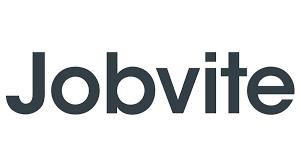
PARTNER WITH US
Designing better ways to work by providing cutting-edge products and exceptional experiences within HR, Talent, Time Management, Benefits and Payroll.

LEARN MORE
LEARN MORE



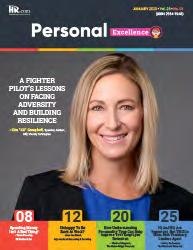





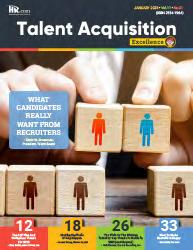


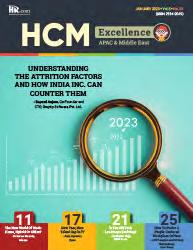
Like to submit an article? Use our online submission form or for more information go to www.hr.com/ExcellencePublications Publications 13 Targeted Publications to Reach Your Audience Informing, Educating, Enlightening and Assisting HR professionals in their personal and professional development, the Excellence series offers high-quality content through the publications!

For more information: Phone: 1.877.472.6648 | Email: ePubeditors@hr.com | www.HR.com/epubs Human Experience Excellence September 2023











 - Brenda Pohlman, Practice Leader, Workhuman
- Brenda Pohlman, Practice Leader, Workhuman




















 Dave Ulrich
Rensis Likert Professor, Ross School of Business, University of Michigan Partner, The RBL Group
Dave Ulrich
Rensis Likert Professor, Ross School of Business, University of Michigan Partner, The RBL Group


























































































 By Brenda Pohlman, Workhuman
By Brenda Pohlman, Workhuman























